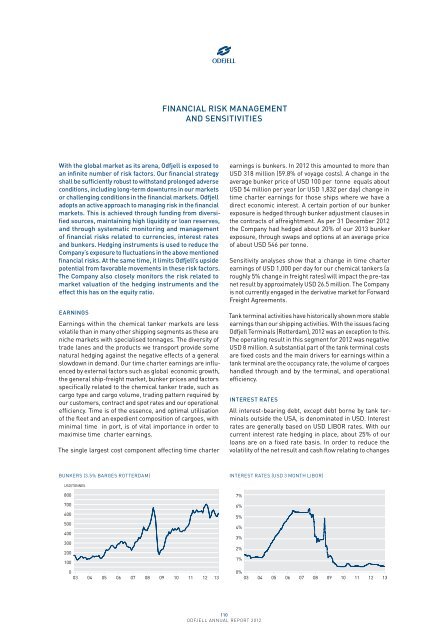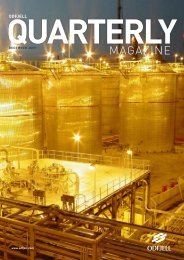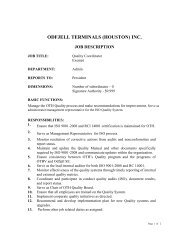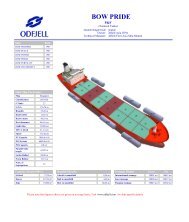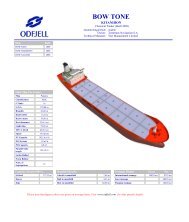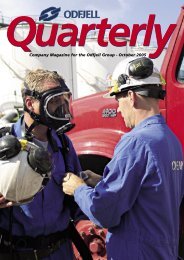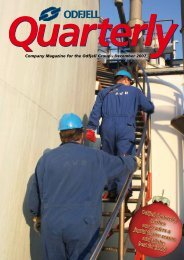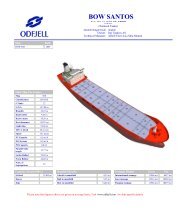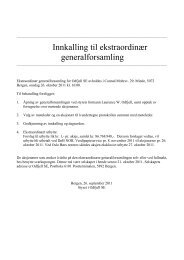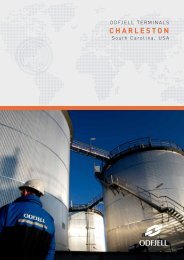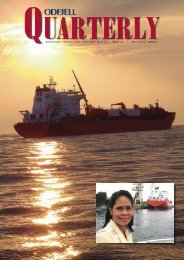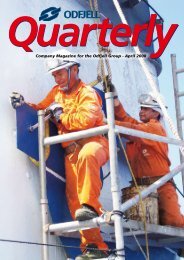Odfjell SE Annual Report 2012
Odfjell SE Annual Report 2012
Odfjell SE Annual Report 2012
You also want an ePaper? Increase the reach of your titles
YUMPU automatically turns print PDFs into web optimized ePapers that Google loves.
FINANCIAL RISK MANAGEMENT<br />
AND <strong>SE</strong>NSITIVITIES<br />
With the global market as its arena, <strong>Odfjell</strong> is exposed to<br />
an infinite number of risk factors. Our financial strategy<br />
shall be sufficiently robust to withstand prolonged adverse<br />
conditions, including long-term downturns in our markets<br />
or challenging conditions in the financial markets. <strong>Odfjell</strong><br />
adopts an active approach to managing risk in the financial<br />
markets. This is achieved through funding from diversified<br />
sources, maintaining high liquidity or loan reserves,<br />
and through systematic monitoring and management<br />
of financial risks related to currencies, interest rates<br />
and bunkers. Hedging instruments is used to reduce the<br />
Company’s exposure to fluctuations in the above mentioned<br />
financial risks. At the same time, it limits <strong>Odfjell</strong>’s upside<br />
potential from favorable movements in these risk factors.<br />
The Company also closely monitors the risk related to<br />
market valuation of the hedging instruments and the<br />
effect this has on the equity ratio.<br />
EARNINGS<br />
Earnings within the chemical tanker markets are less<br />
volatile than in many other shipping segments as these are<br />
niche markets with specialised tonnages. The diversity of<br />
trade lanes and the products we transport provide some<br />
natural hedging against the negative effects of a general<br />
slowdown in demand. Our time charter earnings are influenced<br />
by external factors such as global economic growth,<br />
the general ship-freight market, bunker prices and factors<br />
specifically related to the chemical tanker trade, such as<br />
cargo type and cargo volume, trading pattern required by<br />
our customers, contract and spot rates and our operational<br />
efficiency. Time is of the essence, and optimal utilisation<br />
of the fleet and an expedient composition of cargoes, with<br />
minimal time in port, is of vital importance in order to<br />
maximise time charter earnings.<br />
The single largest cost component affecting time charter<br />
earnings is bunkers. In <strong>2012</strong> this amounted to more than<br />
USD 318 million (59.8% of voyage costs). A change in the<br />
average bunker price of USD 100 per tonne equals about<br />
USD 54 million per year (or USD 1,832 per day) change in<br />
time charter earnings for those ships where we have a<br />
direct economic interest. A certain portion of our bunker<br />
exposure is hedged through bunker adjustment clauses in<br />
the contracts of affreightment. As per 31 December <strong>2012</strong><br />
the Company had hedged about 20% of our 2013 bunker<br />
exposure, through swaps and options at an average price<br />
of about USD 546 per tonne.<br />
Sensitivity analyses show that a change in time charter<br />
earnings of USD 1,000 per day for our chemical tankers (a<br />
roughly 5% change in freight rates) will impact the pre-tax<br />
net result by approximately USD 26.5 million. The Company<br />
is not currently engaged in the derivative market for Forward<br />
Freight Agreements.<br />
Tank terminal activities have historically shown more stable<br />
earnings than our shipping activities. With the issues facing<br />
<strong>Odfjell</strong> Terminals (Rotterdam), <strong>2012</strong> was an exception to this.<br />
The operating result in this segment for <strong>2012</strong> was negative<br />
USD 8 million. A substantial part of the tank terminal costs<br />
are fixed costs and the main drivers for earnings within a<br />
tank terminal are the occupancy rate, the volume of cargoes<br />
handled through and by the terminal, and operational<br />
efficiency.<br />
INTEREST RATES<br />
All interest-bearing debt, except debt borne by tank terminals<br />
outside the USA, is denominated in USD. Interest<br />
rates are generally based on USD LIBOR rates. With our<br />
current interest rate hedging in place, about 25% of our<br />
loans are on a fixed rate basis. In order to reduce the<br />
volatility of the net result and cash flow relating to changes<br />
bunkers (3.5% barges rotterdam)<br />
interest rates (usd 3 month libor)<br />
USD/TONNES<br />
800<br />
700<br />
600<br />
500<br />
400<br />
300<br />
200<br />
100<br />
0<br />
03 04 05 06 07 08 09 10 11 12 13<br />
7%<br />
6%<br />
5%<br />
4%<br />
3%<br />
2%<br />
1%<br />
0%<br />
03 04 05 06 07 08 09 10 11 12 13<br />
110<br />
odfjell annual report <strong>2012</strong>


